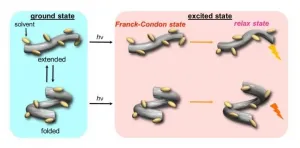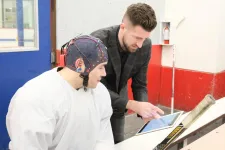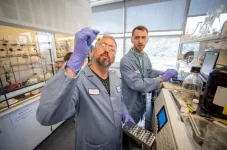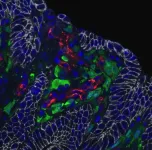Newly developed AI uses combination of ECG and X-ray results to diagnose arrhythmic disorders
2021-04-22
(Press-News.org) Kobe University Hospital's Dr. NISHIMORI Makoto and Project Assistant Professor KIUCHI Kunihiko et al. (of the Division of Cardiovascular Medicine, Department of Internal Medicine) have developed an AI that uses multiple kinds of test data to predict the location of surplus pathways in the heart called 'accessory pathways', which cause the heart to beat irregularly. In this study, the researchers were able to improve diagnosis accuracy by having the AI learn from two completely different types of test results- electrocardiography (ECG) data and X-ray images. It is hoped that this methodology can be applied to other disorders based upon the successful results of this research.
These research results were published online in 'Scientific Reports' on April 13, 2021.
Research Background
Wolff-Parkinson-White (WPW) is an arrhythmic disorder. Patients with WPW syndrome are born with surplus pathways inside their hearts called 'accessory pathways', which can cause tachycardia episodes where the pulse speeds up. Catheter ablation involves using a catheter to selectively cauterize accessory pathways and can completely cure this disorder. However, the success rate of catheter ablation varies depending on the location of the accessory pathways. Conventionally, a 12-lead ECG (i.e. a regular electrocardiography) has been used to predict accessory pathway location prior to treatment. However, this current method that relies solely on ECG is insufficiently accurate, which makes it difficult to give patients a full explanation that includes the success rate of treatment. This research study tried using AI to solve this problem.
The researchers used a methodology for teaching AI called deep learning. Deep learning involves entering the data for each patient and the corresponding answers into a program. By repeating this learning process, the program automatically becomes smarter. Using this methodology, the research group was able to present a solution to a previously unresolved problem, thus further promoting the application of AI to modern medicine.
Research Methodology
Firstly, Dr. Nishimori's team developed AI using only ECG data and compared its performance to previous methods. They conducted repeated learning where they gave the AI each patients' ECG data and the accessory pathway location (i.e. the answer) in each case at the same time, successfully creating an AI with a higher accuracy rate than previous methods. However, the AI was unable to perform correct predictions every time from ECG data alone. The cause of this issue was thought to be that the ECG data is affected by the differences in size and position of each heart, therefore the ECG data did not match even when the location of the accessory pathway was the same. This problem was resolved by having the AI learn data, such as information on each heart's size, from chest x-ray images at the same time (Figure 1). By simultaneously learning both the pre-treatment ECG and X-ray image data, the AI was able to obtain the missing information and its diagnostic accuracy was significantly improved (Figure 2) compared to when only ECG data was used.
Further Developments
The advancement of AI technology in recent years has made it possible for AI to make highly accurate diagnoses based on various kinds of test data in the field of medicine. However, there are cases where data from a single test is insufficient for AI to perform an accurate diagnosis. This research study successfully increased the accuracy by having the AI learn not only from ECG results but also from chest X-ray images, which are a completely different type of data. AI-mediated accurate diagnoses will enable doctors to give pre-treatment patients a more accurate explanation of their condition, which will hopefully put patients at ease. In addition, this research could be applied to various other disorders and will hopefully lead to the implementation of AI diagnosis software.
INFORMATION:
Journal Information:
Title:
"Accessory pathway analysis using a multimodal deep learning model"
DOI: 10.1038/s41598-021-87631-y
Authors:
Makoto Nishimori, Kunihiko Kiuchi, Kunihiro Nishimura, Kengo Kusano, Akihiro Yoshida, Kazumasa Adachi, Yasutaka Hirayama, Yuichiro Miyazaki, Ryudo Fujiwara, Philipp Sommer, Mustapha El Hamriti, Hiroshi Imada, Makoto Takemoto, Mitsuru Takami, Masakazu Shinohara, Ryuji Toh, Koji Fukuzawa, Ken-ichi Hirata
Journal:
Scientific Reports
[Attachments] See images for this press release:
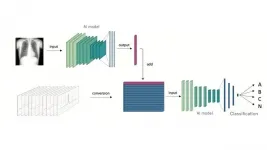
ELSE PRESS RELEASES FROM THIS DATE:
2021-04-22
Stimulus-responsive supramolecular structures have emerged as an alternative to conventional ones, owing to their applications in sensing, drug delivery, and switchable memory systems. Now, scientists at Tokyo Institute of Technology explore the hydrostatic-pressure response of "foldamers"--artificial molecules that mimic protein folding--and report a shift in their preferred conformation with changing pressure, demonstrating hydrostatic pressure-enabled dynamic control. The finding opens doors to future development of pressure-sensitive foldamers and artificial materials.
Most, if not all, biological systems are extremely complex and often rely on interactions traditional ...
2021-04-22
Animals use their sense of smell to navigate the world--to find food, sniff out mates and smell danger. But when a hungry animal smells food and a member of the opposite sex at the same time, what makes dinner the more attractive option? Exactly what is it about the odor of food that says, "Choose me?"
Research by investigators at Harvard Medical School illuminates the neurobiology that underlies food attraction and how hungry mice choose to pay attention to one object in their environment over another.
In their study, published March 3 in Nature, Stephen Liberles and co-author Nao Horio, identified the pathway that promotes attraction ...
2021-04-22
STUDY SHOWS VACCINES MAY PROTECT AGAINST NEW COVID-19 STRAINS ... AND MAYBE THE COMMON COLD
A new study by Johns Hopkins Medicine researchers provides evidence that CD4+ T lymphocytes -- immune system cells also known as helper T cells -- produced by people who have received either of the two messenger RNA (mRNA) vaccines for COVID-19 caused by the original SARS-CoV-2 strain also will recognize the mutant variants of the coronavirus that are rapidly becoming the dominant types worldwide.
The researchers say this suggests that T cell responses elicited or enhanced by the vaccines should be able to control the current ...
2021-04-22
Surrey, B.C. Canada and Rochester, Minn., U.S. (April 22, 2021) - Neuroscience researchers at Mayo Clinic Orthopedics and Sports Medicine in Rochester, Minnesota, U.S., the Health and Technology District and Simon Fraser University (SFU) in Surrey, British Columbia, Canada have published the latest results of their ongoing multi-year hockey concussion study examining changes in subconcussive cognitive brain function in male youth ice hockey players.
The research team monitored brain vital signs during pre- and post-season play in 23 Bantam (age 14 or under) and Junior A (age 16 to 20) male ice-hockey players in Rochester, Minnesota.
"Brain vital signs" translates complex ...
2021-04-22
Plastics are a part of nearly every product we use on a daily basis. The average person in the U.S. generates about 100 kg of plastic waste per year, most of which goes straight to a landfill. A team led by Corinne Scown, Brett Helms, Jay Keasling, and Kristin Persson at Lawrence Berkeley National Laboratory (Berkeley Lab) set out to change that.
Less than two years ago, Helms announced the invention of a new plastic that could tackle the waste crisis head on. Called poly(diketoenamine), or PDK, the material has all the convenient properties of traditional plastics while avoiding the environmental pitfalls, because unlike traditional plastics, PDKs can be recycled indefinitely ...
2021-04-22
Living away from community and country, Aboriginal families of children with severe burns also face critical financial stress to cover the associated costs of health care and treatment, a new study shows.
An Australian study, led by Flinders researchers Dr Courtney Ryder and Associate Professor Tamara Mackean, found feelings of crisis were common in Aboriginal families with children suffering severe burns, with one family reporting skipping meals and others selling assets to reduce costs while in hospital.
The economic hardship was found to be worse in families who live in rural areas - some households travelling more ...
2021-04-22
Rising levels of dementia is putting pressure on residential aged care facilities, including in rural and regional centres where nursing homes and staff are already under pressure.
Now a pilot program of personalised interventions, including residents' favourite songs, has been shown to make a big difference to dementia behaviours, drug use and carers' wellbeing.
Harmony in the Bush, a study led by Flinders University in five nursing homes in Queensland and South Australia, developed a multimodal person-centred non-pharmacological intervention program incorporating ...
2021-04-22
A new molecular 'freeze frame' technique has allowed WEHI researchers to see key steps in how the protein MLKL kills cells.
Small proteins called 'monobodies' were used to freeze MLKL at different stages as it moved from a dormant to an activated state, a key process that enables an inflammatory form of cell death called necroptosis. The team were able to map how the three-dimensional structure of MLKL changed, revealing potential target sites that might be targets for drugs - a potential new approach to blocking necroptosis as a treatment for inflammatory diseases.
The research, which ...
2021-04-22
IL-11 is known to promote the development of colorectal cancer in humans and mice, but when and where IL-11 is expressed during cancer development is unknown. "To address these questions experimentally, we generated reporter mice that express the green fluorescent protein (EGFP) gene in interleukin 11 (IL-11)-producing (IL11+) cells in vivo. We found IL-11+ cells in the colons of this murine colitis-associated colorectal cancer model," said Dr. Nishina, the lead author of a study published April 16 in Nature Communications. "The IL-11+ cells were absent from the colon under normal conditions but rapidly appeared in the tissues of mice with colitis and colorectal cancer."
In the study, Dr. Nishina and colleagues characterized the IL-11+ cells by flow cytometry and found that ...
2021-04-22
The human immune defense is based on the ability of white blood cells to accurately identify disease-causing pathogens and to initiate a defense reaction against them. The immune defense is able to recall the pathogens it has encountered previously, on which, for example, the effectiveness of vaccines is based. Thus, the immune defense the most accurate patient record system that carries a history of all pathogens an individual has faced. This information however has previously been difficult to obtain from patient samples.
The learning immune system can be roughly divided into two parts, of which B cells are responsible for producing antibodies against pathogens, while T cells are responsible for destroying their targets. The measurement of antibodies by traditional laboratory ...
LAST 30 PRESS RELEASES:
[Press-News.org] Newly developed AI uses combination of ECG and X-ray results to diagnose arrhythmic disorders

